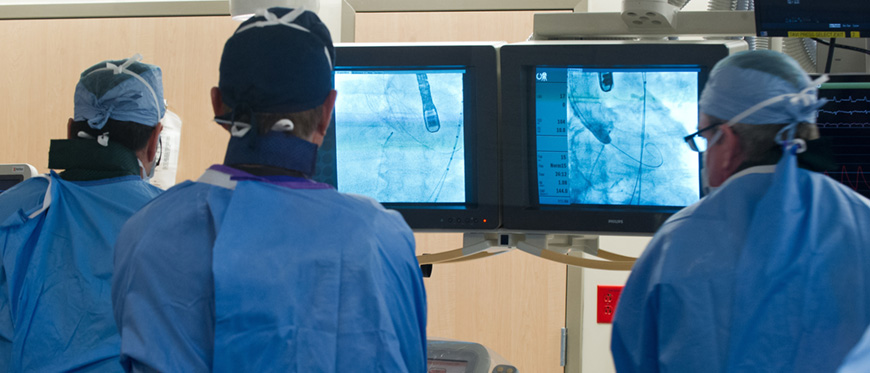
Heart Innovation Reduces Risk, Improves Recovery

Less invasive cardiac care available at the University of Vermont Health Network
An estimated 250 people from Vermont and New York will come through the doors of UVM Health Network hospitals this year with a structural heart abnormality called aortic valve stenosis. This condition narrows the aortic valve and weakens proper heart function. Had any of those patients sought care a decade ago, they would have had a 50 percent chance of dying from the condition within a year, or, if they’d been lucky, they would have had open-heart surgery. Today, thanks to a pioneering treatment offered at UVM Medical Center, the vast majority of those patients will avoid open-heart surgery altogether and instead receive a new valve placed through a less invasive catheter, and will decrease their hospital stay to just 24 to 48 hours.
This procedure, known as transcatheter aortic valve replacement, or TAVR, was first performed at UVM Medical Center in February of 2012 as part of a nationwide, years-long clinical trial for patients at high risk for open-heart surgery. UVM Medical Center cardiologists Drs. Harold Dauerman and Frank Ittleman were co-leaders of that trial.
Patient Perspective: Florence gets her life back with TAVR
UVM Medical Center’s reputation has played a critical role over the years in getting approval for trials such as TAVR – making leading procedures available to patients locally. “One of the advantages of being part of an academic medical center,” said Dr. Dauerman, “is that we’re able to develop new technologies at a fast rate and incorporate them into our clinical practice. There’s no better example of this than TAVR.”
Dr. Ittleman recalls that he was hesitant about TAVR at first. “We’d been doing open-heart valve replacements for decades, and it was the gold standard. So I was a bit conflicted initially, but that feeling quickly dissipated.”
David Schneider, MD, chief of cardiology for the UVM Health Network, says TAVR is a clear benefit for patients. “Ten years ago, if you had to have your aortic valve replaced, we would have had to open your chest, which is a pretty big surgery. The patient was intubated, stayed in the hospital 3 to 5 days, and recovered in the intensive care unit (ICU). Now we can put those valves in with a catheter, which involves putting a tube in your leg, with the valve collapsed in a stent.”
VIDEO: How does the TAVR procedure work?
Ninety percent of patients who have the TAVR procedure go home the next day and can get back to work and their daily lives within a week. In contrast, open-heart patients may take well over a month, sometimes several months, to get back to their regular activities.
About four months ago, the UVM Medical Center cardiology team performed its 1000th TAVR procedure. And today, Drs. Dauerman and Ittleman envision a future where mitral and other heart valves could be replaced with catheters that avoid open surgical procedures. “Less invasive cardiac surgery is the cutting edge right now,” says Dr. Ittleman. “We’re learning a lot more about approaching the heart in less invasive ways. We’re realizing that it can be done safely, expeditiously and to the patient’s benefit in terms of recovery. And our TAVR patients are perfect examples of this new technology.”
To learn more about the TAVR program at UVM Medical Center, visit our website.
